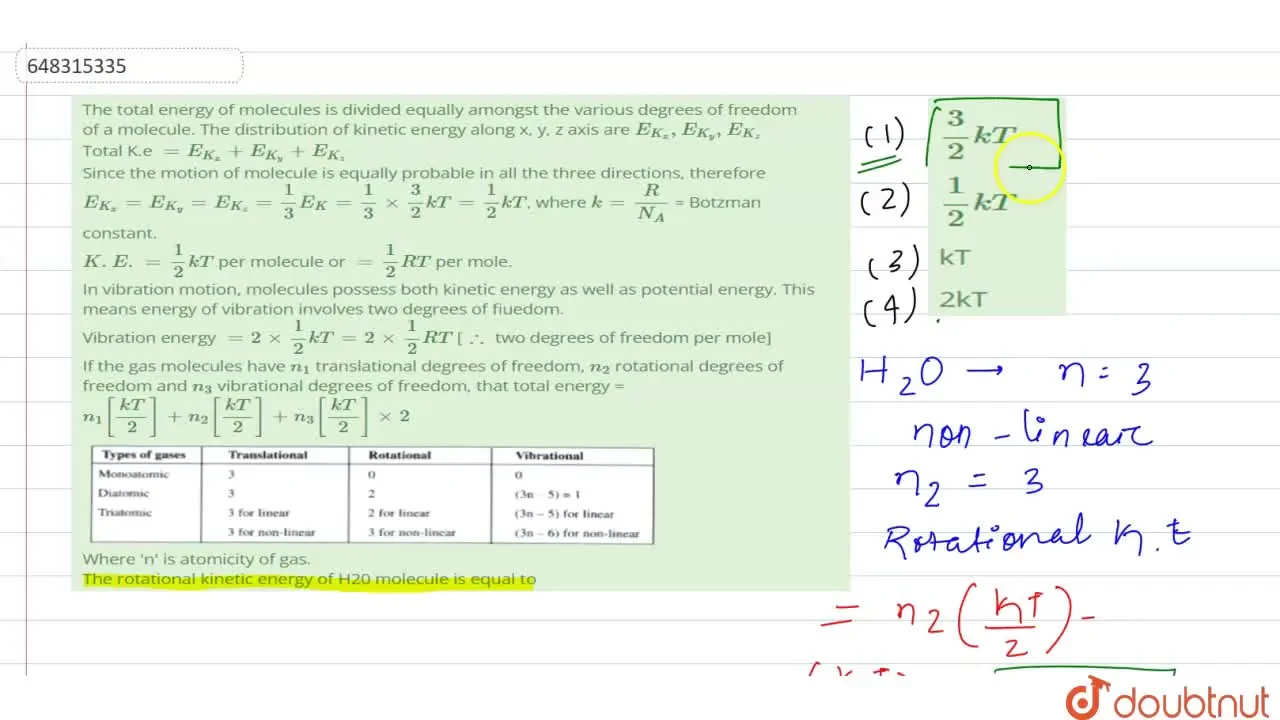The total energy of molecules is divided equally amongst the various degrees of freedom of a molecule. The distribution of kinetic energy along x, y, z axis are EKx,EKy,EKz
Total K.e =EKx+EKy+EKz
Since the motion of molecule is equally probable in all the three directions, therefore
EKx=EKy=EKz=13EK=13×32kT=12kT, where k=RNA = Botzman constant.
K.E.=12kT per molecule or =12RT per mole.
In vibration motion, molecules possess both kinetic energy as well as potential energy. This means energy of vibration involves two degrees of fiuedom.
Vibration energy =2×12kT=2×12RT [∴ two degrees of freedom per mole]
If the gas molecules have n1 translational degrees of freedom, n2 rotational degrees of freedom and n3 vibrational degrees of freedom, that total energy = n1[kT2]+n2[kT2]+n3[kT2]×2
![The total energy of molecules is divided equally amongst the various degrees of freedom of a molecule. The distribution of kinetic energy along x, y, z axis are E(K(x)), E(K(y)), E(K(z)) Total K.e =E(K(x)) + E(K(y)) + E(K(z)) Since the motion of molecule is equally probable in all the three directions, therefore E(K(x)) = E(K(y)) = E(K(z)) =1/3 E(K) =1/3 xx 3/2 kT = 1/2 kT, where k =R/N(A) = Botzman constant. K.E. = 1/2 kT per molecule or =1/2 RT per mole. In vibration motion, molecules possess both kinetic energy as well as potential energy. This means energy of vibration involves two degrees of fiuedom. Vibration energy =2 xx 1/2kT =2 xx 1/2RT [therefore two degrees of freedom per mole] If the gas molecules have n(1) translational degrees of freedom, n2 rotational degrees of freedom and n(3) vibrational degrees of freedom, that total energy = n(1)[(kT)/2] + n(2) [(kT)/2] + n(3) [(kT)/2] xx 2 Where 'n' is atomicity of gas. The rotational kinetic energy of H20 molecule is equal to](https://d10lpgp6xz60nq.cloudfront.net/physics_images/AKS_AO_CHE_V01_P2_C02_E02_087_Q01.png)
Where 'n' is atomicity of gas.
The rotational kinetic energy of H20 molecule is equal to
32kT
12kT
kT
2kT
The correct Answer is:A
Step by step video & image solution for The total energy of molecules is divided equally amongst the various degrees of freedom of a molecule. The distribution of kinetic energy along x, y, z axis are E_(K_(x)), E_(K_(y)), E_(K_(z)) Total K.e =E_(K_(x)) + E_(K_(y)) + E_(K_(z)) Since the motion of molecule is equally probable in all the three directions, therefore E_(K_(x)) = E_(K_(y)) = E_(K_(z)) =1/3 E_(K) =1/3 xx 3/2 kT = 1/2 kT, where k =R/N_(A) = Botzman constant. K.E. = 1/2 kT per molecule or =1/2 RT per mole. In vibration motion, molecules possess both kinetic energy as well as potential energy. This means energy of vibration involves two degrees of fiuedom. Vibration energy =2 xx 1/2kT =2 xx 1/2RT [therefore two degrees of freedom per mole] If the gas molecules have n_(1) translational degrees of freedom, n_2 rotational degrees of freedom and n_(3) vibrational degrees of freedom, that total energy = n_(1)[(kT)/2] + n_(2) [(kT)/2] + n_(3) [(kT)/2] xx 2 Where 'n' is atomicity of gas. The rotational kinetic energy of H20 molecule is equal to by Chemistry experts to help you in doubts & scoring excellent marks in Class 12 exams.
Similar Questions
The total energy of molecules is divided equally amongst the various degrees of freedom of a molecule. The distribution of kinetic energy along x, y, z axis are EKx,EKy,EKz
Total K.e =EKx+EKy+EKz
Since the motion of molecule is equally probable in all the three directions, therefore
EKx=EKy=EKz=13EK=13×32kT=12kT, where k=RNA = Botzman constant.
K.E.=12kT per molecule or =12RT per mole.
In vibration motion, molecules possess both kinetic energy as well as potential energy. This means energy of vibration involves two degrees of fiuedom.
Vibration energy =2×12kT=2×12RT [∴ two degrees of freedom per mole]
If the gas molecules have n1 translational degrees of freedom, n2 rotational degrees of freedom and n3 vibrational degrees of freedom, that total energy = n1[kT2]+n2[kT2]+n3[kT2]×2

Where 'n' is atomicity of gas.
The vibrational kinetic energy of CO2 molecule isView SolutionThe total energy of molecules is divided equally amongst the various degrees of freedom of a molecule. The distribution of kinetic energy along x, y, z axis are EKx,EKy,EKz
Total K.e =EKx+EKy+EKz
Since the motion of molecule is equally probable in all the three directions, therefore
EKx=EKy=EKz=13EK=13×32kT=12kT, where k=RNA = Botzman constant.
K.E.=12kT per molecule or =12RT per mole.
In vibration motion, molecules possess both kinetic energy as well as potential energy. This means energy of vibration involves two degrees of fiuedom.
Vibration energy =2×12kT=2×12RT [∴ two degrees of freedom per mole]
If the gas molecules have n1 translational degrees of freedom, n2 rotational degrees of freedom and n3 vibrational degrees of freedom, that total energy = n1[kT2]+n2[kT2]+n3[kT2]×2

Where 'n' is atomicity of gas.
How many total degrees of freedom are present in H2 molecules in all types of motions ?View SolutionDerive an expression for the mean K.E. of a gas molecule.
View SolutionTotal kinetic energy of molecules of a gas sample varies K.E.=74nRT. This sample contains
View SolutionThe magnitude of binding energy of the satellite is E and kinetic energy is K. The ratio E/K is
View SolutionWhich of the following is correct if E0x+x>E0y+y>E0z+z
View SolutionThe Threshold energy is given as E0 and radiation of energy E falls on metal then K.E is given as
View SolutionThe ratio of average translational K.E. and average rotational K.E. of a linear polyatomic molecule at temperature T is:
View SolutionIf EpandEk represent potential energy and kinetic energy respectively of an orbital electron, then, according to Bohr.s theory :
View SolutionIf the area bounded by y=x2andy=21+x2 is (K1π−K23) sq. units (where K1,K2∈Z), then the value of (K1+K2) is equal to
View Solution


